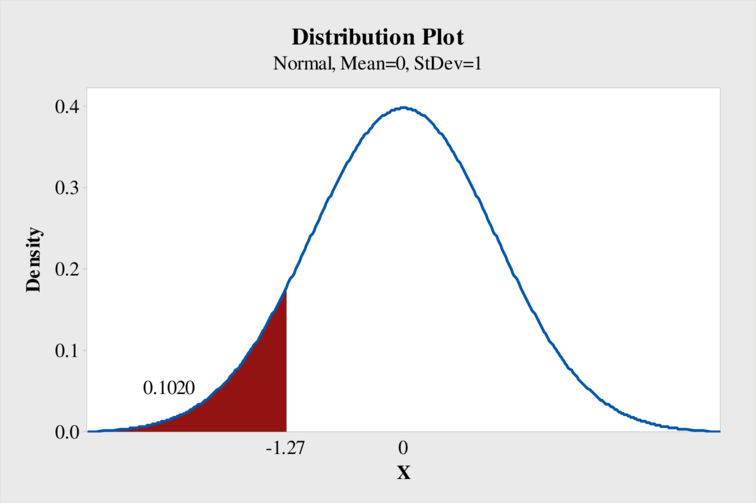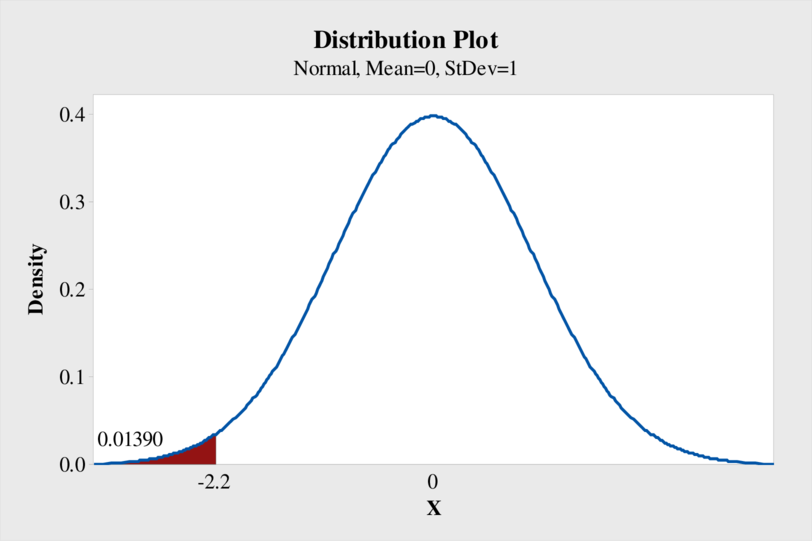
a.
Construct a 95% confidence interval for the proportion favoring the Republican candidate.
a.
Answer to Problem 66CE
The 95% confidence interval for the proportion favoring the Republican candidate is (0.489, 0.551).
Explanation of Solution
Calculation:
In this case, the number of voters favoring the Republican candidate is 520
Step-by-step procedure to find the 95% confidence interval for the proportion favoring the Republican candidate using MINITAB software:
- Choose Stat > Basic Statistics > 1 Proportion.
- Choose Summarized data.
- In Number of
events , enter 520 and in Number of trials, enter 1,000. - Check Options, enter Confidence level as 95.0.
- Choose not equal in alternative.
- Click OK in each dialog box.
Output is obtained as follows:

From the output, the 95% confidence interval for the proportion favoring the Republican candidate is (0.489, 0.551).
b.
Find the
b.
Answer to Problem 66CE
The probability that the Democratic candidate is actually leading with is 0.102.
Explanation of Solution
Calculation:
In this case, the
The mean (p) is 0.52 and the standard deviation is 0.0158
Hence, the sampling distribution follows normal with mean of 0.52 and standard deviation of 0.0158.
The probability that the Democratic candidate is actually leading is obtained as follows:
Step-by-step procedure to find the probability value using MINITAB software:
- Choose Graph > Probability Distribution Plot >View Probability > OK.
- From Distribution, choose ‘Normal’ distribution.
- Enter Mean as 0 and Standard deviation as 1.
- Click the Shaded Area tab.
- Choose X Value and Left Tail for the region of the curve to shade.
- Enter the data value as –1.27.
- Click OK.
Output using MINITAB software is obtained as follows:

Thus, the probability that the Democratic candidate is actually leading is 0.102.
c.
Construct a 95% confidence interval for the proportion favoring the Republican candidate when the number of voters is 3,000.
Find the probability that the Democratic candidate is actually leading.
c.
Answer to Problem 66CE
The 95% confidence interval for the proportion favoring the Republican candidate is (0.502, 0.538).
The probability that the Democratic candidate is actually leading is 0.0132.
Explanation of Solution
Calculation:
In this case, the number of voters favoring the Republican candidate is 1,560
Step-by-step procedure to find the 95% confidence interval for the proportion favoring the Republican candidate using MINITAB software:
- Choose Stat > Basic Statistics > 1 Proportion.
- Choose Summarized data.
- In Number of events, enter 1,560 and in Number of trials, enter 3,000.
- Check Options, enter Confidence level as 95.0.
- Choose not equal in alternative.
- Click OK in each dialog box.
Output is obtained as follows:

From the output, the 95% confidence interval for the proportion favoring the Republican candidate is (0.502, 0.538).
In this case, the sample size (=3,000) is larger. Therefore, the mean and standard deviation of the sampling distribution using central limit theorem is
The mean (p) is 0.52 and the standard deviation is 0.0091
Hence, the sampling distribution follows normal with mean of 0.52 and standard deviation of 0.0091.
The probability that the Democratic candidate is actually leading is obtained as follows:
Step-by-step procedure to find the probability value using MINITAB software:
- Choose Graph > Probability Distribution Plot >View Probability > OK.
- From Distribution, choose ‘Normal’ distribution.
- Enter Mean as 0 and Standard deviation as 1.
- Click the Shaded Area tab.
- Choose X Value and Left Tail for the region of the curve to shade.
- Enter the data value as –2.20.
- Click OK.
Output using MINITAB software is obtained as follows:

Thus, the probability that the Democratic candidate is actually leading is 0.0139.
Want to see more full solutions like this?
Chapter 9 Solutions
STATISTICAL TECHNIQUES FOR BUSINESS AND
- please find the answers for the yellows boxes using the information and the picture belowarrow_forwardA marketing agency wants to determine whether different advertising platforms generate significantly different levels of customer engagement. The agency measures the average number of daily clicks on ads for three platforms: Social Media, Search Engines, and Email Campaigns. The agency collects data on daily clicks for each platform over a 10-day period and wants to test whether there is a statistically significant difference in the mean number of daily clicks among these platforms. Conduct ANOVA test. You can provide your answer by inserting a text box and the answer must include: also please provide a step by on getting the answers in excel Null hypothesis, Alternative hypothesis, Show answer (output table/summary table), and Conclusion based on the P value.arrow_forwardA company found that the daily sales revenue of its flagship product follows a normal distribution with a mean of $4500 and a standard deviation of $450. The company defines a "high-sales day" that is, any day with sales exceeding $4800. please provide a step by step on how to get the answers Q: What percentage of days can the company expect to have "high-sales days" or sales greater than $4800? Q: What is the sales revenue threshold for the bottom 10% of days? (please note that 10% refers to the probability/area under bell curve towards the lower tail of bell curve) Provide answers in the yellow cellsarrow_forward
- Business Discussarrow_forwardThe following data represent total ventilation measured in liters of air per minute per square meter of body area for two independent (and randomly chosen) samples. Analyze these data using the appropriate non-parametric hypothesis testarrow_forwardeach column represents before & after measurements on the same individual. Analyze with the appropriate non-parametric hypothesis test for a paired design.arrow_forward
- Should you be confident in applying your regression equation to estimate the heart rate of a python at 35°C? Why or why not?arrow_forwardGiven your fitted regression line, what would be the residual for snake #5 (10 C)?arrow_forwardCalculate the 95% confidence interval around your estimate of r using Fisher’s z-transformation. In your final answer, make sure to back-transform to the original units.arrow_forward
 Holt Mcdougal Larson Pre-algebra: Student Edition...AlgebraISBN:9780547587776Author:HOLT MCDOUGALPublisher:HOLT MCDOUGAL
Holt Mcdougal Larson Pre-algebra: Student Edition...AlgebraISBN:9780547587776Author:HOLT MCDOUGALPublisher:HOLT MCDOUGAL Big Ideas Math A Bridge To Success Algebra 1: Stu...AlgebraISBN:9781680331141Author:HOUGHTON MIFFLIN HARCOURTPublisher:Houghton Mifflin Harcourt
Big Ideas Math A Bridge To Success Algebra 1: Stu...AlgebraISBN:9781680331141Author:HOUGHTON MIFFLIN HARCOURTPublisher:Houghton Mifflin Harcourt Glencoe Algebra 1, Student Edition, 9780079039897...AlgebraISBN:9780079039897Author:CarterPublisher:McGraw Hill
Glencoe Algebra 1, Student Edition, 9780079039897...AlgebraISBN:9780079039897Author:CarterPublisher:McGraw Hill College Algebra (MindTap Course List)AlgebraISBN:9781305652231Author:R. David Gustafson, Jeff HughesPublisher:Cengage Learning
College Algebra (MindTap Course List)AlgebraISBN:9781305652231Author:R. David Gustafson, Jeff HughesPublisher:Cengage Learning




